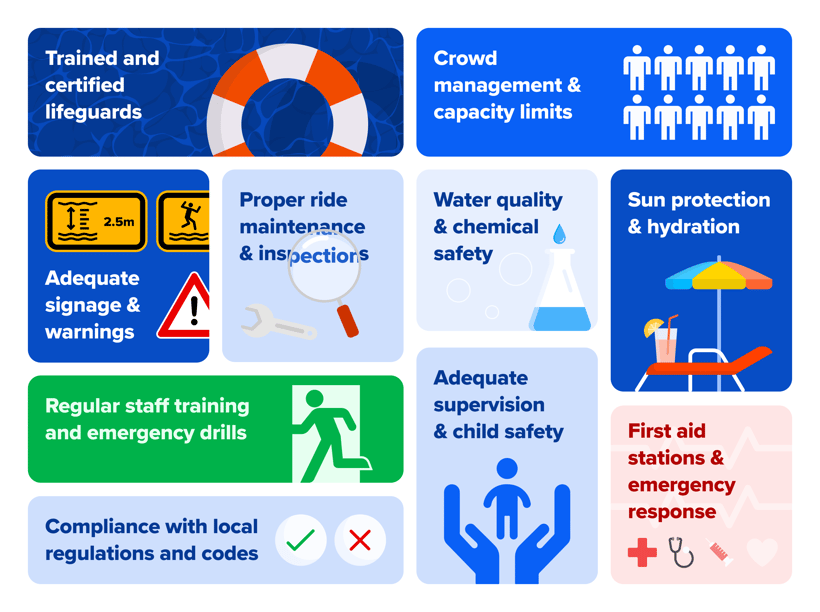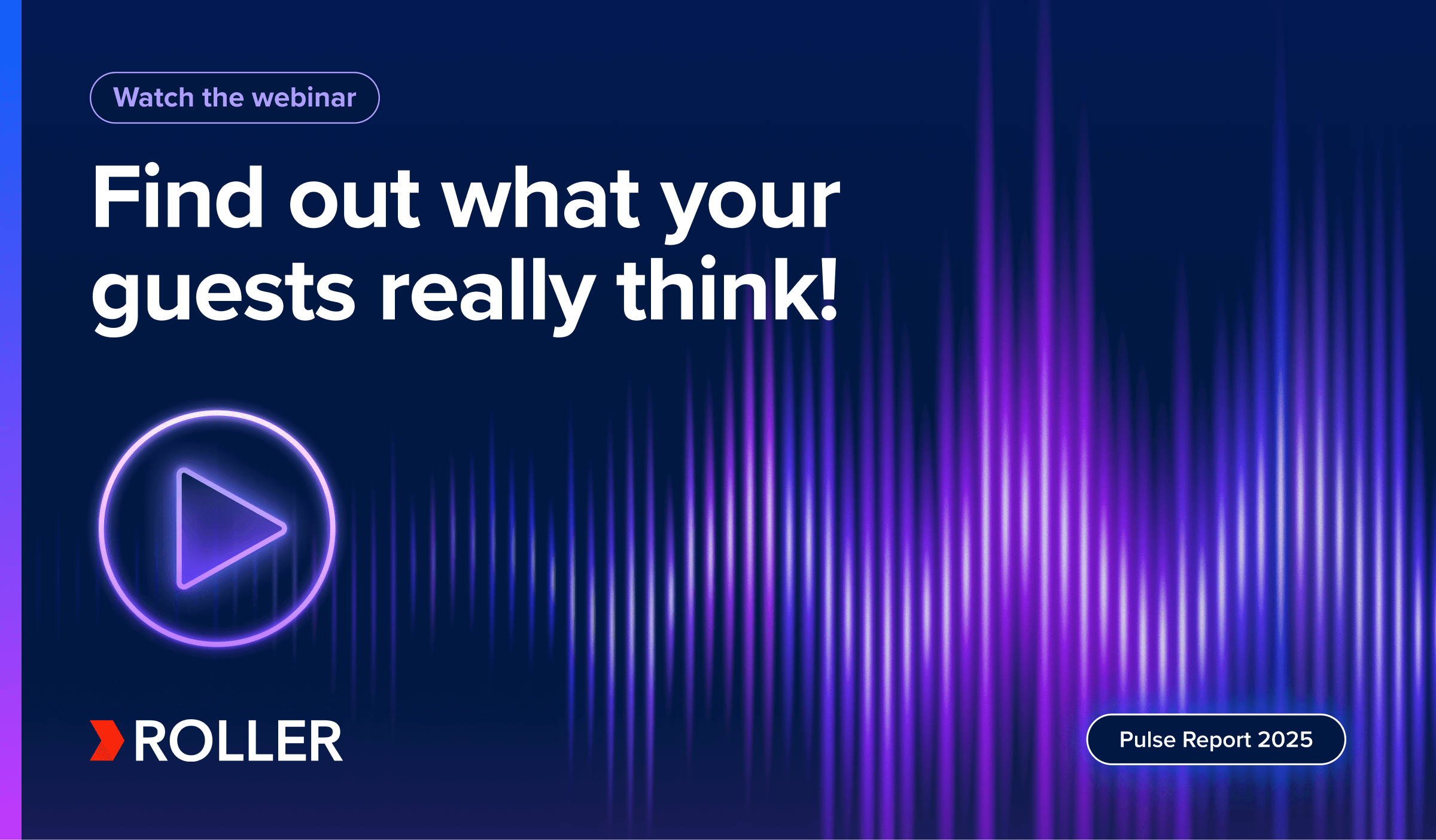Water Park Safety Checklist for Operators

Water parks are popular destinations for families and thrill-seekers alike, offering a refreshing escape from the summer heat and a range of exciting water attractions.
As a water park venue operator, ensuring the safety and well-being of your guests is paramount. Some safety recommendations fall squarely to your guests – like ensuring children are adequately supervised and that all guests remain sun-safe, but by implementing a comprehensive safety checklist, you can create a secure and enjoyable environment for all guests while managing your liability.
In this blog, we'll outline a water park safety checklist to help venue operators from diving into risky business.
1. Are all lifeguards trained and certified?
Water park lifeguards and coaches should receive regular training to maintain their skills, enhance safety measures, and provide excellent guest experiences. Here’s what to focus on:
- Safety and Emergency Response: Water parks can be high-risk environments, and lifeguards are responsible for ensuring the safety of all guests. Regular training helps lifeguards maintain and improve their skills in recognizing and responding to emergencies, such as drowning incidents, injuries, or water-related accidents. Proper training equips lifeguards to handle these situations effectively and promptly, potentially saving lives.
- Skill Maintenance: Lifeguarding skills require constant practice and refinement. Regular training helps lifeguards stay sharp and proficient in essential techniques like rescue procedures, first aid, CPR, and using life-saving equipment. Practicing these skills regularly ensures that lifeguards can react quickly and confidently when emergencies occur.
- Changes in Protocols and Regulations: Water park safety standards, protocols, and regulations may change over time. Regular training keeps lifeguards updated on the latest best practices and guidelines, ensuring they comply with new regulations and provide the best possible care for park guests.
- Identifying and Managing Risk: Lifeguards must be skilled in identifying potential risks in the water park environment and taking appropriate preventive measures. Regular training helps lifeguards understand the specific hazards present in their park, how to address them, and how to communicate with park-goers about safety.
- Teamwork and Communication: Lifeguards often work in teams to cover different water park areas. Regular training fosters effective communication and coordination among lifeguards, helping them work together seamlessly during emergencies and day-to-day operations.
- Dealing with High-Stress Situations: Water park lifeguards must be prepared to handle high-stress situations calmly and confidently. Regular training includes scenario-based exercises, which allow lifeguards to practice decision-making under pressure and improve their ability to stay composed during emergencies.
The frequency of training for water park lifeguards depends on various factors, including local regulations, the water park's complexity, and the staff's experience level. However, here are some general guidelines:
- Basic Training: All new lifeguards should undergo comprehensive training before starting their duties. This training typically includes lifeguard certification courses, first aid training, CPR certification, and learning water park-specific protocols.
- Refresher Training: Lifeguards should receive refresher training periodically, ideally every 1 to 3 months. This training should cover essential skills like rescue techniques, victim assessment, and emergency response procedures. Lifeguards can also participate in scenario-based exercises to practice decision-making in various emergencies.
- Ongoing Education: Lifeguards should have access to ongoing educational opportunities, such as workshops, seminars, and online courses. These programs can cover topics like advanced first aid techniques, risk management, communication skills, and crowd control.
It's important to note that the above training frequencies are general recommendations, and the actual schedule should be based on the unique circumstances of each water park or coaching organization. Some parks may conduct more frequent training to ensure optimal safety and performance, while others may follow a slightly different schedule based on their operational requirements and available resources.
2. Have you displayed adequate signage and warnings in the required areas?
Adequate signage and warnings in water parks are crucial for several reasons:
- Safety Awareness: Water parks have various attractions, pools, and features that may pose certain risks to guests. Signage helps raise awareness about potential hazards and informs guests of safety guidelines and rules, reducing the likelihood of accidents or injuries.
- Liability and Legal Compliance: Water parks have a duty of care to provide a safe environment for their guests. Adequate signage demonstrates that the park has taken reasonable steps to inform guests about potential risks and safety measures. This can help protect the park from liability in case of accidents or incidents.
- Guest Education: Many guests may not be familiar with water park rules or safe behaviors around water attractions. Clear and informative signage educates guests about proper conduct, height and age restrictions, and safety protocols, ensuring an enjoyable and risk-free experience.
- Accessibility and Inclusivity: Signage should be designed to accommodate all guests, including those with disabilities. Braille signs, visual symbols, and multi-lingual signs can make information accessible to everyone, ensuring that safety instructions are understood by all.
- Crowd Management: During peak hours, water parks can become crowded, making it important to use signage to direct the flow of guests and manage queues appropriately. This helps prevent congestion and maintain a smooth guest experience.
The types of signage that should be included in water parks may vary depending on the park's specific layout and attractions. However, some common types of signage include:
- Safety Rules and Warnings: Signs near water attractions should indicate safety guidelines, height restrictions, and any medical conditions that might prevent participation. Signs with emergency phone numbers or contact details for park staff and medical assistance should be placed throughout the park.
- Depth Markers: These signs are essential in pools to indicate water depths, helping guests understand where it is safe to swim and where diving is permitted.
- First Aid Stations: Signs leading to first aid stations should be easily visible, allowing guests to quickly locate medical assistance.
- Handicap Accessibility Signs: These signs should provide information about accessible facilities and services for guests with disabilities.
- Queue Management Signs: Signs should direct guests to queue lines and indicate wait times for popular attractions.
Overall, well-designed and strategically placed signage contributes to a safer and more enjoyable experience for water park guests by promoting awareness, guiding behavior, and facilitating effective communication during both routine operations and emergencies.
3. Waivers can provide you with liability protection
Waivers are crucial as they can provide some liability protection by outlining inherent risks and obtaining participants’ acknowledgment of those risks. They ensure informed consent by notifying participants about potential dangers, allowing them to make an informed decision about their participation. Waivers serve as a risk management tool, demonstrating your business’s commitment to safety and reducing the likelihood of frivolous claims.
ROLLER’s integrated digital waiver software automates and streamlines the sending, signing, and storing waivers. Not only does this help your venue manage risk, but it saves staff and guests time at check-in and provides a valuable source of guest data for future marketing campaigns.
4. Conduct regular maintenance and inspections of all rides and equipment
Regular maintenance and inspections of all rides and equipment are essential to ensure a water park's safety and proper functioning. The frequency and depth of these checks may vary based on the manufacturer's recommendations, local regulations, and the age and complexity of the rides.
Some key aspects should be included in the maintenance and inspection process:
Mechanical Checks
- Inspect all mechanical components of rides and attractions, including hinges, bearings, joints, wheels, pulleys, and support structures.
- Look for signs of wear and tear, corrosion, rust, or any parts requiring lubrication, replacement, or repair.
- Test mechanical systems to ensure smooth operation and proper functionality.
Electrical Checks
- Conduct routine inspections of electrical systems and components, such as wiring, switches, circuit breakers, and control panels.
- Check for loose connections, damaged wires, or any electrical hazards that may pose a risk to guests or staff.
- Verify that all safety mechanisms, such as emergency stop buttons, are operational.
Exterior Surfaces
- Regularly assess the condition of exterior surfaces of rides and equipment, including slides, staircases, walkways, and pool areas.
- Look for cracks, chips, rough surfaces, or any damage that may present safety risks to guests.
- Address any sharp edges or protruding parts that could cause injuries.
Interior Surfaces
- Inspect the interior surfaces of water slides and attractions, ensuring they are smooth and free from any obstacles or debris that may interfere with guest safety.
- Check pool bottoms for uneven surfaces or potential tripping hazards.
- Examine pool linings and coatings for signs of wear or damage.
Water Quality and Filtration
- Regularly test and maintain the water quality in all pools and attractions to ensure proper chemical balance and sanitation.
- Check filtration systems to ensure they function effectively to keep the water clean and clear.
5. Do the water quality and chemical safety levels meet health and safety standards?
Water park operators can ensure water quality and chemical safety levels meet health and safety standards through a combination of proactive measures, regular testing, proper maintenance, and staff training.
Water Testing and Monitoring
- Implement a regular and comprehensive water testing program to monitor the chemical levels and water quality in all pools and attractions.
- Conduct tests multiple times a day, especially during peak operating hours, to ensure consistency in water quality.
Proper Chemical Handling and Storage
- Train staff on safely handling, mixing, and storing water treatment chemicals.
- Use appropriate protective gear when handling chemicals, and store them in a secure and designated area away from guest areas.
Regular Maintenance & Disinfection
- Maintain and clean filtration systems regularly to ensure they effectively remove impurities and contaminants from the water.
- Use approved disinfection methods, such as chlorine or bromine, to kill harmful bacteria and viruses in the water.
- Monitor disinfectant levels and adjust to maintain the appropriate range.
Water Circulation & pH Balance
- Ensure proper water circulation and turnover rates in all pools and attractions to prevent stagnation and improve water quality.
- Regularly check and adjust the pH levels of the water to ensure it remains within the recommended range for effective disinfection and comfort of swimmers.
6. Have first aid stations and emergency response areas been established?
Here are the most important steps for water park operators to establish first aid stations and emergency response areas:
- Site Selection: Choose accessible and visible locations for first aid stations and emergency response areas throughout the water park.
- Equipment and Training: Equip stations with essential medical supplies and designated first aid and CPR-trained staff.
- Communication and Signage: Clearly mark locations with visible signage and establish effective communication systems for emergency alerts.
- Emergency Response Plans: Develop comprehensive emergency response plans and regularly train staff on protocols.
By focusing on these key steps, water park operators can quickly and effectively respond to medical emergencies, enhancing guest safety and well-being.
7. Closely manage crowd management and capacity limits
Water park operators have to ride a wave of responsibility when it comes to keeping their venue safe. And believe it or not, it all starts with closely managing capacity. Here’s how to do just that:
- Advanced Ticketing and Reservations: Implement an advanced water park ticketing system that allows guests to purchase tickets and make reservations online. This helps control the number of guests entering the park daily and prevents overcrowding. To learn more about ROLLER’s Progressive Checkout, visit us online.
- Access Control and Turnstiles: Install entry control points with turnstiles or automated access systems linked to the water park venue management software. This ensures that only guests with valid tickets or reservations can enter, helping manage the flow of visitors.
- Event Scheduling and Capacity Limits: Plan special events with consideration for crowd size, ensuring that the venue management software you choose helps monitor capacity limits for these events as well.
- Guest Analytics: Gather data on guest flow, attendance patterns, and attraction popularity. This data can be used to make informed decisions about park operations and improve crowd management strategies.
- Analyze Reviews: Continuously review crowd management measures and adjust based on guest feedback and operational data to optimize crowd flow and enhance the overall guest experience. ROLLER’s Guest Experience Score can help you do just that!
By leveraging venue management software and employing these crowd management strategies, water park operators can effectively control visitor numbers, avoid overcrowding, and provide guests a safe and enjoyable experience.
ROLLER can help simplify capacity management with state-of-the-art bookings and scheduling technology. Find out more here.
Water park safety is not just a drop in the bucket
Running a safe water park requires meticulous planning, attention to detail, and a commitment to continuous improvement. By implementing the water park safety checklist outlined above, venue operators can create a secure and enjoyable environment for guests of all ages.
Please note: This article is not intended as legal advice. Venues should coordinate with the appropriate bodies for specific information about regulations/guidelines.
Related articles


2025 Pulse Report Webinar: Operators Unpack the Guest Insights

Indoor Playground Software Buyer’s Guide: How to Compare POS Systems and More
Enhance your guest experience
Get free education, tips and inspiration to help you run a successful venue.